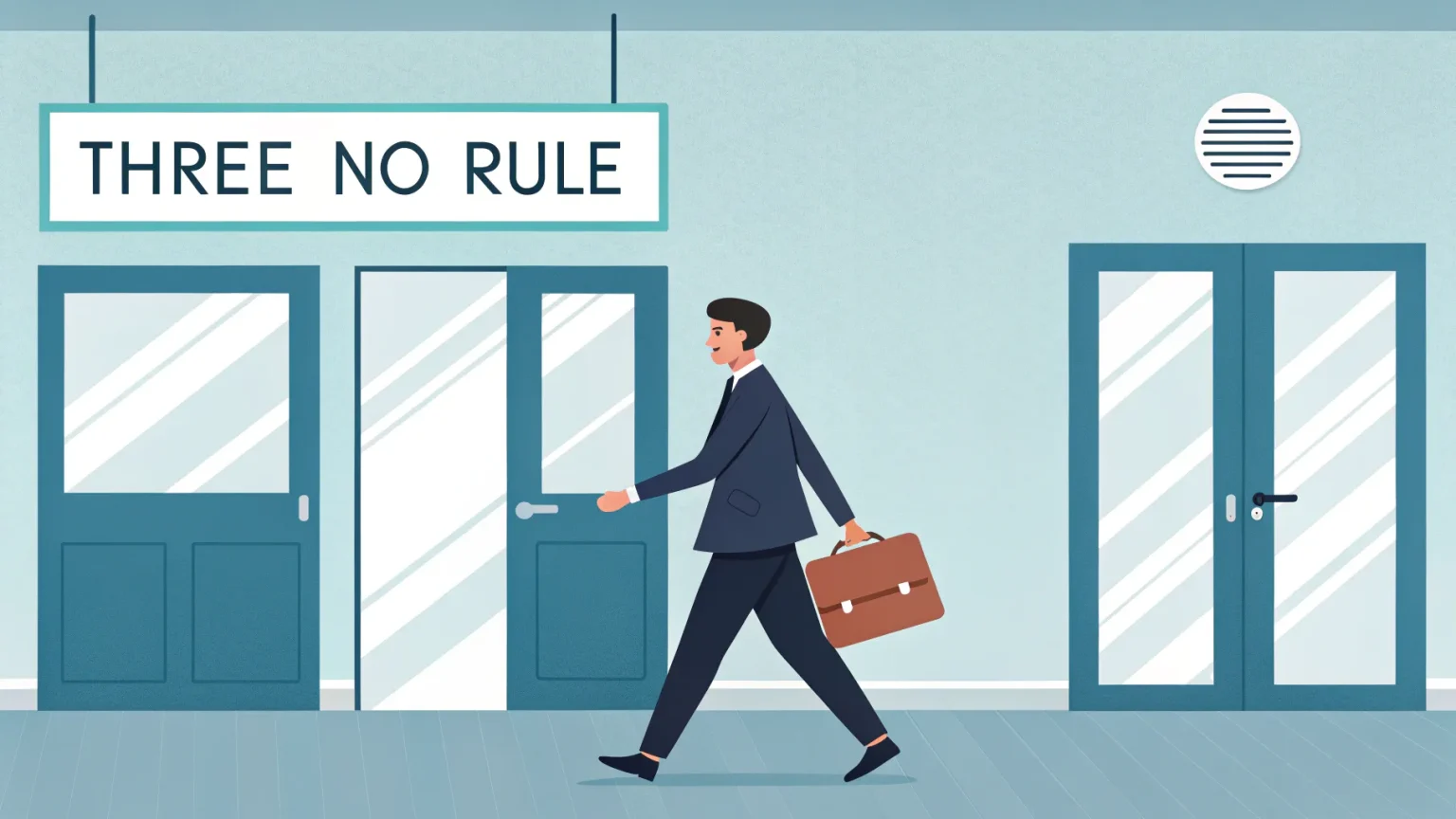In sales, time is money. But too often, we waste precious hours chasing prospects who aren’t ready to commit. Over my years building businesses and closing deals, I’ve developed a simple yet powerful principle that has saved me countless hours and dramatically improved my closing rate. I call it the “Three No Rule,” and it’s transformed how I approach sales negotiations.
When someone shows interest but keeps delaying the final decision, it’s usually not about external circumstances—it’s about internal hesitation. The universe has a way of telling us when something isn’t meant to be. My rule is straightforward: after three postponements or cancellations, it’s time to call it what it is.
How the Three No Rule Works
Let me walk you through a typical scenario. A potential client says, “I’ll let you know on Wednesday whether I’d like to move forward.” Wednesday arrives, but there’s a snowstorm and they can’t make it. That’s one no.
They apologize and reschedule for Friday, expressing genuine interest in moving forward. But when Friday comes, they have a family emergency and need to postpone again. That’s two nos.
Then comes the third meeting attempt. Their calendar gets mixed up, and they call apologizing profusely about the confusion. That’s three nos—and my signal to take action.
At this point, instead of setting up a fourth attempt, I say something like: “I’m getting a feeling this isn’t the right time or place for this deal. Unless you really want to do it right now, I think I’ll wait. You can let me know when you’re truly ready, and we’ll get it done then. Does that sound fair?”
The Psychology Behind the Technique
This approach works because it:
- Removes pressure from the prospect
- Shifts the dynamic from you chasing them to them pursuing you
- Creates a now-or-never moment that forces a decision
- Respects both parties’ time and energy
The beauty of this technique is that it cuts through the noise and reveals the prospect’s true intentions. If they’re genuinely interested but just disorganized or overwhelmed, this approach gives them permission to commit now rather than continue the dance.
What happens next is revealing: about 50% of the time, the person will say, “Let’s do it now.” They suddenly find the motivation to move forward when they realize you’re prepared to walk away. The other 50% will confirm what you already suspected—they weren’t serious buyers in the first place.
Saving Time and Energy
The most valuable aspect of the Three No Rule is how much time it saves. In business, especially in sales, we can get caught in the trap of optimism—believing that with just one more call or meeting, we’ll close the deal. But this optimism often leads to wasted weeks or months pursuing prospects who were never going to convert.
By implementing this rule, I’ve freed up enormous amounts of time to focus on qualified prospects who are ready to move forward. It’s not about being impatient—it’s about being efficient and respecting the signals the universe sends us.
This approach also preserves your professional dignity. Instead of becoming increasingly desperate with each follow-up, you maintain your position as a valued partner whose time is precious. This often increases your perceived value in the eyes of the prospect.
When to Be Flexible
Of course, there are exceptions to every rule. If you’re dealing with a major potential client or a unique opportunity, you might extend beyond three nos. The key is to be intentional about these exceptions rather than making them the norm.
I’ve found that being clear about my boundaries actually earns respect from serious clients. They appreciate working with someone who values their own time and, by extension, will value the client’s time as well.
The Three No Rule isn’t about being rigid—it’s about recognizing patterns and responding accordingly. It’s about listening to what the universe is telling you through these repeated delays and having the courage to act on that information.
Next time you find yourself rescheduling that third meeting with a prospect, remember this rule. Say the words, step back, and watch what happens. You might be surprised how many deals suddenly close—and how much time you save on the ones that weren’t meant to be.
Frequently Asked Questions
Q: Isn’t it risky to potentially walk away from a deal that might eventually close?
The risk of walking away is far outweighed by the opportunity cost of continuing to chase reluctant prospects. My experience shows that if someone is truly interested after three postponements, they’ll respond to this approach by committing immediately. If not, you’ve saved valuable time that can be invested in more promising opportunities.
Q: How do you deliver the “three no” message without sounding confrontational?
Tone is everything. I present it as an observation rather than an accusation, using phrases like “I’m getting a feeling” and “Does that sound fair?” This makes it clear I’m not upset or blaming them—I’m simply recognizing a pattern and offering a path forward that respects both our time.
Q: Does this approach work in all industries and sales contexts?
While the specific implementation might vary, the core principle works across most B2B and high-value B2C sales environments. The key is understanding your sales cycle—in some industries with naturally longer decision processes, you might need to adjust what constitutes a “no” versus a normal part of the process.
Q: What if there are legitimate reasons for all three postponements?
Even with legitimate reasons, three postponements usually indicate something deeper. Either the timing isn’t right, the prospect isn’t fully convinced, or other priorities are consistently taking precedence. The Three No Rule acknowledges this reality rather than fighting against it. If the prospect truly wants to proceed despite the delays, they’ll respond positively to your final offer.
Q: How do you keep track of the “nos” with multiple prospects?
A good CRM system is essential for implementing this approach effectively. I make notes after each interaction, including any postponements or cancellations. This helps me track patterns across my prospect pipeline and apply the Three No Rule consistently without having to rely on memory alone.







